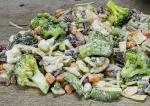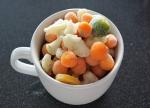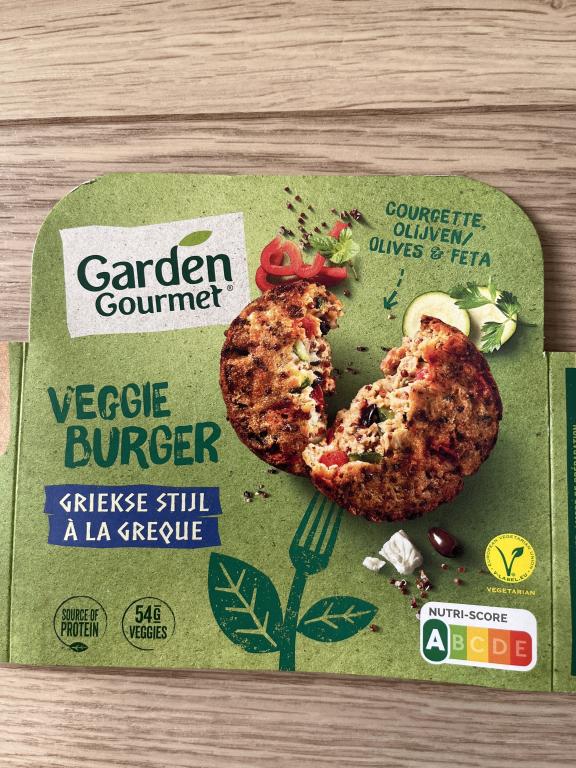
The European market potential for frozen vegetables
Globally, Europe represents one of the largest markets for frozen vegetables. In the long term, the European market for frozen vegetables is expected to show a stable growth of 1–3% annually. This growth is likely to be driven by changes in the consumption patterns of European consumers, including ‘ready to eat’ and ‘easy to prepare’ meals and replacing food of animal origin with vegetable alternatives. Germany, France, Belgium, the United Kingdom, Italy and the Netherlands offer the best opportunities for developing country suppliers.
Contents of this page
1. Product description
Frozen vegetables are fresh vegetables that are frozen when they reach maturity. Depending on the vegetable, they are washed, peeled, grated, chopped, cut or blanched before freezing. Vegetables can also be grilled or seasoned with spices or oil before freezing. The freezing operation is carried out quickly to avoid water crystallisation. The quick-freezing process is not regarded as complete until the product temperature has reached -18°C at the thermal centre of the vegetable after thermal stabilisation.
Frozen vegetables are produced either as Individual Quick Frozen (IQF) where each piece is separated from other pieces, or they are stuck together in blocks. They can be produced in different forms:
- Whole (e.g. peas, asparagus, Brussels sprouts);
- Cut in different forms (e.g. rings, diced, strips). Cutting is the most common for carrots, but it is used for other vegetables too (e.g. onions, leeks, green beans). Cutting the vegetable to get florets is typical for cauliflower and broccoli;
- Chopped to form cubes, balls and similar shapes (e.g. spinach);
- Purees/pulps (e.g. carrots, avocadoes, pumpkins, spinach).
Figure 1: Frozen vegetables
IQF frozen beans

Frozen spinach

Frozen broccoli and other vegetables

Frozen peas

Frozen cauliflower and other vegetables

Frozen mixed vegetables

Source: Pixabay
This study covers general information regarding the frozen vegetables market in Europe, which is of interest to producers in developing countries. See a selection of products in Table 1 for statistical analysis. Please note that frozen potatoes are not part of this survey, as they are mostly produced and traded within Europe and imports from developing countries are insignificant. When the study refers to ‘Europe’, it refers to the 27 Member States of the European Union, plus the United Kingdom, Switzerland, Norway, Iceland and Liechtenstein. Developing countries are defined as the countries listed as official development assistance recipients.
Table 1: Frozen vegetable product group
| CN number | Product |
| 07102100 | Frozen peas (Pisum sativum) |
| 07102200 | Frozen beans (Vigna spp, Phaseolus spp) |
| 071029 | Other frozen leguminous vegetables (uncooked or cooked by steaming or boiling) |
| 071030 | Spinach, New Zealand spinach and orache spinach (garden spinach) |
| 071040 | Frozen sweet corn |
| 07108010 | Frozen olives (uncooked or cooked) |
| 07108051 | Frozen sweet peppers (uncooked or cooked) |
| 07108059 | Frozen vegetables of the genus capsicum or pimenta (uncooked or cooked) |
| 07108061 | Frozen mushrooms of the genus Agaricus (uncooked or cooked) |
| 07108069 | Other frozen mushrooms (uncooked or cooked) |
| 07108070 | Frozen tomatoes (uncooked or cooked) |
| 07108080 | Frozen artichokes (uncooked or cooked) |
| 07108085 | Frozen asparagus (uncooked or cooked) |
| 07108095 | Other frozen vegetables (uncooked or cooked) |
| 07109000 | Mixture of frozen vegetables (uncooked or cooked) |
| 20049010 | Frozen sweetcorn prepared or preserved otherwise than by vinegar or acetic acid |
| 20049030 | Frozen sauerkraut, capers and olives, prepared or preserved otherwise than by vinegar or acetic acid |
| 20049091 | Frozen cooked onions |
| 20049098 | Other frozen vegetables and mixtures of vegetables, prepared or preserved otherwise than by vinegar or acetic acid |
2. What makes Europe an interesting market for frozen vegetables?
Europe has the largest demand worldwide for frozen vegetables, with a 47% share of the global import in 2023, followed by North America. In 2023, frozen vegetable imports to Europe reached 3.3 million tonnes at a value of €791 million. Over the past five years, the import quantity has been relatively stable with only slight fluctuations, but the value increased by 7%, indicating an increase in import prices.
Over the next five years, the European market for frozen vegetables is likely to increase at an annual growth rate of 1–3%. The main reason for the expected market growth is convenience and increasing consumption of ready-to-eat frozen food. Vegetables, both frozen and fresh, are increasingly being consumed due to the growing popularity of vegan and vegetarian food across Europe. Regular fluctuations in imports will continue to be influenced by harvested crop volumes and accessory price developments rather than changes in demand.
Internal European trade accounts for 87% of all imports, and imports from developing countries for 13%. Europe is the largest producer of frozen vegetables in the world, which is why there is such a large share of internal trade in the total imports. European imports from developing countries increased by 4% in quantity over the last five years, reaching 422,000 tonnes in 2023.
Source: Eurostat and ITC TradeMap, 2024
Tip:
- For information about the European market for processed fruits and vegetables, see the website of PROFEL, the European Association of Fruit and Vegetable Processing Industries.
3. Which European countries offer the most opportunities for frozen vegetables?
As Europe’s main importers of frozen vegetables, Germany and France are interesting focus markets. The UK is especially interesting as it ranks first in imported volumes from developing countries. Belgium, although the largest producer and exporter, does not produce all types of vegetables domestically, and it commonly sources some frozen vegetables from other countries. Other top European markets include Italy, the Netherlands, Spain, Portugal and Sweden.
Source: ITC TradeMap, 2024
Germany: Leader in the frozen vegetable market
Germany is the world’s third-largest importer of frozen vegetables (after the United States and Japan) and the largest in Europe. In 2023, German frozen vegetable imports had a total value of €791 million, or 17% of the European market. The volume of German imports decreased by 0.9% every year between 2019 and 2023, to 622,000 tonnes. However, their value increased by 7% per year over the same period due to higher import prices.
In 2023, Germany imported 89% of its frozen vegetables from other European countries and 11% from developing countries. Belgium is the leading supplier to Germany, with a 41% share, followed by the Netherlands (16%), Poland (15%) and Spain (8%). Of the non-European countries, China is the leading supplier of frozen vegetables to Germany. Turkey, Ecuador, Egypt and Morocco are the other main suppliers.
In 2023, the most imported vegetables to Germany were frozen broccoli and cauliflower florets, which had more than a 30% share, followed by frozen vegetable mixtures (16%), prepared frozen vegetables/ready meals (10%) and frozen spinach (7%). The leading frozen vegetables imported from developing countries are frozen broccoli, frozen sweet peppers, frozen mushrooms, frozen tomatoes and frozen asparagus.
German frozen vegetable consumption is being driven by changing lifestyles, convenience, growing preference for vegan and organic diets and demand for seasonal vegetables throughout the year. In 2022, research by ProVeg showed that 51% of Germans have reduced their meat intake. According to the Vegan Society, Germany and Austria have the highest number of vegans, after the UK. Around 30% of Germans have adopted a flexitarian diet (a primarily vegetarian diet, with occasional consumption of meat or fish).
Edeka Group, Schwarz Group, Rewe Group, and Aldi Group are top retail suppliers of frozen vegetables in the German market. Private label brands also operate in the German market. Some well-known ones are Gut & Günstig, Edeka, Rewe Beste Wahl, ja! and Rewe Bio. Examples of independent brands of frozen vegetables in Germany include Frosta and Iglo.
Tips:
- Visit the German Waren-Verein trade association website and German company directory Wer Liefert Was to find frozen vegetables traders.
- Stay up to date on developments in the German frozen vegetable market using the dti Publikationen application developed by the German Frozen Food Institute (in German only).
France: Another promising frozen vegetable market in Europe
France is the second-largest importer of frozen vegetables in Europe and fourth-largest in the world. In terms of value, its imports reached €713 million in 2023, accounting for 15% of all European imports. However, the volume of French imports fell by 3% between 2019 and 2023, to 524,000 tonnes. A growing preference for seasonal foods is expected to boost frozen vegetable sales across the country.
Belgium is the leading direct supplier to France, followed by Spain, Poland and the Netherlands. Among non-European countries, China is the leading supplier, followed by Turkey and Egypt.
According to data from the French Sector Association of Processed and Frozen Vegetables (UNILET), consumption of frozen vegetables is high in France. In 2020, 83% of French households consumed frozen vegetables at home. Almost 57% of domestic vegetables harvested were frozen. Demand was highest for peas, spinach, courgette and broccoli, followed by vegetable mixes. There was a marked increase in frozen vegetable buyers buying for distributor brands (private labels).
Consumption of frozen organic vegetables increased by 3% in volume in 2021 and 6% in value relative to 2019. The organic segment represents 6% of the market in volume and 9% in value.
Nutri-Score labelling is used in France to indicate the nutritional value of products (including frozen vegetables). Leading frozen vegetable brands include Bonduelle, Picard, Findus, d’Aucy and Paysan Breton.
Tips:
- Consult UNILET’s member directory to learn more about French frozen vegetables companies.
- Find French frozen food importers via Europages.
The United Kingdom: Growing innovative market
The United Kingdom is showing a slight decrease in imports of frozen vegetables. Imports have decreased from 466,000 tonnes in 2019 to 426,000 tonnes in 2023. This decrease in imports can be explained by price inflation affected by a combination of factors, such as Brexit and the war in Ukraine. Frozen peas, green beans and vegetable mixtures account for the bulk of retail sales. Frozen sweet corn is also very popular, shown by the fact that the United Kingdom is the largest importer of this product in the world.
The products that show a significant increase in sales are frozen onions diced into cubes and frozen chopped garlic. The main reason for this trend is the busy lifestyle of UK consumers who want to save time on the preparation of vegetables. This is also convenient for foodservice companies. Other products that have increased in sales are frozen cauliflower and frozen broccoli. Vegan and vegetarian food are becoming increasingly popular in the UK, boosting sales of easy to prepare frozen vegetables, such as seasoned and grilled ones.
The market share of independent frozen vegetable brands is decreasing, while the share of private labels (brands owned by retail chains) is increasing. The supply of private labels is becoming more centralised. A specific characteristic of the UK market is increasing sales by specialised frozen food retailers, such as Iceland and FarmFoods. The leading independent frozen vegetables brand in the UK is Bird’s Eye.
Tip:
- Learn more about retail and foodservice sales of frozen vegetables on the UK market on the website of the British Frozen Food Federation.
Belgium: Leading European producer of frozen vegetables
Belgium is the largest producing, exporting and re-exporting country for frozen vegetables in Europe. It accounted for 35% of total European exports in 2023. Germany, France, the United Kingdom, the Netherlands and the United States of America are the main export destinations for frozen vegetables from Belgium.
In 2023, Belgium was the fourth largest importing country in Europe, with a share of 11%, after Germany, France and the United Kingdom. Over the past five years, Belgian imports of frozen vegetables have decreased at an average rate of 0.5% but increased in value by 10% per year. This significant difference between value and volume indicates increasing import prices. In 2023, Belgian imports reached €483 million and 384,000 tonnes.
Belgian production of frozen vegetables is concentrated in the regions of East Flanders and West Flanders and focuses mainly on carrots, beans, spinach, peas, cauliflower and Brussels sprouts. Belgian companies do not source all of their vegetables domestically, and frozen vegetables that are not produced in Belgium are sourced from other countries.
France is the leading supplier of frozen vegetables to Belgium, accounting for a 24% market share, followed by the Netherlands, Spain and Poland. Not all frozen vegetable imports are consumed within Belgium, where domestic consumption is low. A portion is packed, re-processed and re-exported to other European destinations. Most imported frozen vegetables to Belgium are frozen broccoli and cauliflower, followed by is the frozen sweet peppers.
Among non-European countries, China is the leading supplier to Belgium with frozen broccoli, cauliflower and garlic as the main exported products. Other important developing country suppliers are Ecuador (frozen broccoli) Egypt (frozen artichokes), Turkey (frozen tomatoes and sweet peppers) and the Balkan countries (Serbia, Croatia and North Macedonia, all with frozen sweet peppers as the leading export product).
Leading manufacturers, retailers and distributors of frozen vegetables that sell under their own brands include ARDO, Greenyard, Flanders Best and Dujardin Foods. Private labels are the leading frozen vegetable brands, such as those of leading retailer Delhaize (Delhaize and 365), while Iglo is the leading premium brand. Key trends driving Belgium frozen vegetable consumption are health and convenience. Almost all leading frozen vegetable products have Nutri-Score labels.
Tip:
- To learn more about the Belgian frozen vegetable sector, see the website of the Flemish Centre for Agricultural and Food Marketing (in Dutch only; you can use Google Translate to read it).
Italy: Fifth-largest importer of frozen vegetables
Italy is the fifth largest importer of frozen vegetables in Europe. In 2023, its total aggregated imports were 242,000 tonnes. The majority was for internal consumption and export volumes were low. Between 2019 and 2023, imports increased at an annual rate of 2% in volume and by 8% in value per year. Italy is one of the only countries in Europe that underwent a positive import growth since 2019.
The leading supplier of frozen vegetables to Italy in 2023 was Belgium, with a 30% market share, followed by Spain (18%) and Poland (9%). Among the leading suppliers to Italy, Poland has gained the most significant market share. Poland doubled its exports to Italy, from 10,000 tonnes in 2019 to 21,000 tonnes in 2023. Among non-European countries, China is the leading supplier, followed by Egypt and Turkey. Italy is the largest European importer of frozen mushrooms.
The most imported frozen vegetables to Italy are frozen broccoli and cauliflower, followed by frozen mushrooms and prepared and ready-to-eat frozen vegetable mixtures and meals. The main imported vegetable from developing countries (mostly China) is frozen mushrooms. Frozen mushrooms are a very popular ingredient in pizza and pasta dishes in the food service segment. Another popular ingredient in Italian cuisine are frozen artichokes, which are mostly imported from Egypt.
Some leading names in the Italian frozen food retail and manufacturing sectors are Orogel, Surmont, Carnevale, Emilia Foods (selling under their private label), Alifoods and Asiago Foods (private labels).
The Netherlands: Highest increase in frozen vegetable imports among all European countries
The Netherlands is the sixth largest importer of frozen vegetables in Europe. Between 2019 and 2023, Dutch imports increased steadily, with a 6% annual increase in value and a 2% annual increase in volume. In 2023, imports reached 197,000 tonnes and €290 million. In terms of volume, Belgium is the largest supplier, making up a 46% share, followed by Germany (15%), France (8%) and Spain (6%). Within the supply from Europe, Denmark’s market share is growing. Imports from Denmark increased from 720 tonnes in 2019 to 3,500 in 2023.
The major suppliers from non-European countries are China, Turkey, Ecuador and Egypt. Other emerging suppliers from developing countries are Vietnam, Mexico and Morocco. China supplies a wide range of frozen vegetables to the Netherlands, such as frozen garlic, broccoli, bamboo shoots and Asian mushrooms. Turkey mostly supplies frozen tomatoes and sweet pepper. Ecuador only supplies frozen broccoli, while Egypt mostly supplies frozen artichoke and okra.
The Netherlands is not only an importer but also a producer, exporter and transit country for the re-export of frozen vegetables. It was the fourth largest supplier of frozen vegetables in the world in 2023, after China, Belgium and Spain, with 325,000 tonnes in export volumes. Sales are dominated by private labels, with Albert Heijn being the leading retail chain. Leading independent brands are Bonduelle and Iglo. Mondial Foods, one of the leading Dutch export and trading companies, has worldwide coverage in the frozen vegetable trade.
Tip:
- See the list of IQF frozen vegetable manufacturers, processors and suppliers in the Netherlands on Frozen Goods.
4. Which trends offer opportunities or pose threats in the European frozen vegetable market?
Increasing demand for foods that are convenient and fast to prepare as well as for vegan and vegetarian options are driving demand for frozen vegetables in Europe. Frozen vegetables are promoted as nutritionally richer than fresh vegetables that are refrigerated. Greater demand for organic food, coupled with an increasing preference for seasonal vegetables, is also creating growth in the European frozen vegetable industry.
Convenience and ease of preparation
Many European frozen food companies are developing time-saving frozen food solutions specifically for consumers with busy lifestyles. In Europe, Germany is leading the way in frozen innovations, followed by the United Kingdom, Italy and Spain. These solutions include different ethnic mixes, ready-to-eat frozen vegetable dishes and frozen vegetable alternatives to meat. European consumers are open to different options including grilled, pre-fried and pre-cooked frozen vegetables.
The trend of convenience is also shaping the foodservice industry. Many restaurants, fast food chains and hotels are increasingly using custom frozen vegetable solutions. For example, frozen herbs are sometimes more convenient than fresh herbs, which have a very short shelf life. Frozen vegetable smoothies (e.g. green vegetable mixtures) are also growing in popularity.
The range of applications that frozen vegetables can be used for is expanding, and innovative solutions include different ethnic mixes, frozen vegetable purees, frozen vegetable alternatives to meat (Figure 4) and ready-to-eat frozen vegetable dishes. In order to cut preparation time, most newly introduced products are vegetables that just need to be defrosted or heated for a short time. This includes grilled and pre-fried frozen vegetables and pre-cooked and fully prepared meals.
Figure 4: Vegetable burger alternative

Source: Photo by k0m0d0r3, Open Food Facts under Creative Commons Attribution-Share Alike 3.0 Unported license
Health awareness among younger generations
Growing awareness of healthy lifestyles among Europeans is increasing demand for healthy food and beverage products. According to the INC, a recent survey by IRI International found that two-thirds (70%) of people across Europe buy healthy foods, and that 60% believe eating more fruit and vegetables will make them healthier. Recently, several high-profile incidents have also raised questions about food safety at retail chains, making people increasingly mindful of food quality. Demand for ‘free from’, ‘organic’ and ‘vegetarian’ products is rising. Penetration levels of each category are already significant, with organic and vegetarian food accounting for 53% and 39%, respectively, of all consumer food purchases.
Environmental awareness
Recent years have also seen growing awareness about the environment and animal protection. In many parts of Europe, meat consumption has declined significantly, creating opportunities for innovation in vegetable products. The consumption of plant-based alternatives over animal products has grown fivefold since 2011 (starting from a very low basis), and it is likely to continue to grow further according to the European Union Agricultural Outlook 2023–2035 report (PDF). Overall, EU per capita meat consumption could decline to 1.6 kg in 2035 as compared to 67 kg per capita in 2023. This will create more opportunities for (frozen) vegetable suppliers.
More EU consumers are following a ‘flexitarian’ diet (30% as of 2021), characterised by a preference for plant-based food products but allowing for occasional meat and fish. This represents a higher percentage than that of vegans and vegetarians. Thus, an increase in demand for plant-based food will likely be fuelled by flexitarians seeking out occasional substitutes for meat. For example, in Germany, about 13% of young adults aged 18–29 categorise themselves as vegan or vegetarian, compared to only 6% in Italy and 10% in France.
Some popular meat alternatives are frozen vegetable burgers (with a high content of beans as an animal protein alternative), frozen chickpea products (e.g. hummus, falafel), frozen vegetable snacks (e.g. root vegetable fries), cauliflower pieces as a rice substitute and ready-to-eat vegetable mixtures (e.g. curry-type dishes, vegetable-cereal combinations, pizzas with a cauliflower crust).
Innovations to compete with private labels
Private label players are becoming increasingly innovative as brands seek to differentiate and add value. They are exploring new processing methods, new product varieties and fun features such as unusual product shapes and packaging designs. For example, Bonduelle introduced steamed vegetables as a new processing method, while Frosta introduced emotive marketing with a heart-shaped frozen spinach range to enhance brand affinity and make cooking more enjoyable.
Tip:
M-Brain carried out this study and updated by Autentika Global on behalf of CBI.
Please review our market information disclaimer.
Search
Enter search terms to find market research